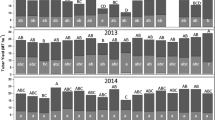Summary
After harvestc 124000, tubers/ha of cvs. Redskin and Majestic remained in a field at the Scottish Horticultural Research Institute (SHRI). Of these about one fifth were on the surface, the remainder being buried in the top 20 cm of soil. Surveys of fields which had recently been planted with potatoes indicated that large numbers of groundkeepers can survive through many years of cereal monoculture. On average, the number of daughter tubers per volunteer plant was greater than one and their average size remained constant. Winter soil temperatures are apparently not low enough in this part of Scotland to kill a high proportion of the buried tubers. The sharp fall in the numbers of volunteer plants noted on two occasions was tentatively related to the growing the year before of more open crops such as raspberry and vegetables which are usually repeatedly weeded at the SHRI.
Zusammenfassung
Auf einem Feld des Scottish Horticultural Research Institute blieben nach der Ernte und zweimaligem Eggen bis zu einer Tiefe von ca. 20 cm ungefähr 124000 Knollen/ha der Sorten Redskin und Majestic zurück. Von diesen lag ca. ein Fünftel auf der Oberfläche, der Rest befand sich bis zu 20 cm Tiefe im Boden (Tabelle 1). Die Knollen knapp unter oder auf der Bodenoberfläche sind wahrscheinlich erfroren. Die Anzahl der im folgenden Jahr auskeimenden und Pflanzen bildenden Knollen weist darauf hin, dass von den begrabenen Knollen der Sorte Redskin ungefähr die Hälfte und von der Sorte Majestic ungefähr ein Viertel in Aeckern überlebten, die im Winter nicht bestellt, und etwas weniger in Aeckern, die im Winter bestellt wurden (Tabelle 1). Die durchschnittliche Grösse der Mutterknollen von überlebenden Pflanzen neight dazu, grösser zu sein als jene der begrabenen Knollen. Sie steht im Einklang mit den Ergebnissen aus andern Feldern, bei denen die ursprüngliche Anpflanzung schon einige Jahre zurück lag (Tabelle 2 und 4). Eine Ueberprüfung von früher mit Kartoffeln bepflanzten Feldern zeigte, dass eine grosse Anzahl im Boden verbleibender Knollen, die oftmals die Pflanzdichte für Speisekartoffeln überschreitet, dort, wo fortwährend Getreide angebaut wird, viele Jahre überleben kann (Tabelle 3). Im Durchschnitt ist die Anzahl der Tochterknollen pro überlebende Pflanze grösser als eins (Tabelle 5), und die durchschnittliche Grösse der Knollen blieb konstant (Tabelle 4). In diesem Teil von Schottland sind die winterlichen Bodentemperaturen offenbar nicht tief genug, so dass die tiefer begrabenen Knollen nicht erfrieren (Tabelle 3). Die Anzahl ging jedoch stark zurück, wenn eher offene Kulturen, wie Himbeeren und Gemüse, angebaut wurden, wahrscheinlich weil die wiederholte Unkrautbekämpfung die überlebenden Pflanzen vor der Knollenbildung zerstört (Tabelle 3). Wo die Wintertemperaturen nicht tief genug sind, kann durch Einschluss geeigneter Kulturen in die Fruchtfolge, verbunden mit wiederholter Unkrautbekämpfung während der Vegetationszeit, eine gewisse Bekämpfung der überlebenden Pflanzen erzielt werden.
Résumé
Après la récolte et deux hersages à une profondeur d'environ 20 cm, il restait dans le champ de l'Institut Ecossais de Recherches Horticoles (SHRI) quelque 124000 tubercules/ha des cultivars Redskin et Majestic. Un cinquième de ces tubercules se trouvaient à la surface, les autres étant enterrés à 20 cm (tableau 1). Les tubercules à proximité ou sur la surface du sol sont probablement tués par le gel. Les nombres de repousses l'année suivante font supposer que des tubercules enterrés des cultivars Redskin et Majestic, environ la moitié et un quart respectivement, survivaient dans les surfaces qui n'étaient pas cultivées durant l'hiver et un peu moins dans les surfaces qui étaient cultivées durant l'hiver (tableau 1). Le volume moyen des tubercules-mères des repousses avait tendance à être plus grand que celui des tubercules enterrés, ce qui concorde avec les résultats obtenus dans d'autres champs éloignés de plusieurs années de la récolte originelle (tableaux 2 et 4). Un examen des champs précédemment plantés en pommes de terre indique qu'un grand nombre de tubercules restent dans le sol, dépassent souvent la densité de plantation des récoltes principales, peuvent survivre pendant plusieurs années là où l'on cultive continuellement des céréales (tableau 3). En moyenne, le nombre de tubercules-fils par tubercule resté dans le sol est supérieur à un (tableau 5) et la taille moyenne des tubercules reste constant (tableau 4). Les températures hivernales du sol ne sont, apparemment, pas assez basses dans cette partie de l'Ecosse pour tuer les tubercules enterrés plus profondément (tableau 3). Cependant, les nombres tombent beaucoup quand on pratique des cultures plus ouvertes telles que framboisiers et légumes probablement à cause des sarclages répétés détruisant les repousses avant leur tubérisation (tableau 3). Là où les conditions hivernales ne sont pas sévères, on pourrait lutter contre les repousses en introduisant des cultures de rupture accompagnées de sarclages répétés pendant la saison de croissance.
Similar content being viewed by others
References
Doncaster, J. P. & P. H. Gregory, 1948. The spread of virus diseases in the potato crop.Rep. Ser. Agric. Res. Coun. No 7. HMSO, London.
Lumkes, L. M., 1972. (Volunteer potatoes; a problem).Bedrijfsontwikkeling, Ed. Akkerbouw 2: 45–72. (Abstract inFields Crops Abstr. 25, 775, 1972.).
Lumkes, L. M. & H. P. Beukema, 1973. The effect of cultivation procedure on the liability to freezing of groundkeepers.Potato Res. 16: 57–60.
Pérombelon, M. C. M. & R. Lowe, 1971. Bacterial soft rot and black leg of potato.Rep. Scott. hort. Res. Inst. for 1970: 32–33.
Wright, R. C. & M. C. Diehl, 1927. Freezing injury to potatoes.Tech. Bull. U.S. Dep. Agric. No. 27.
Author information
Authors and Affiliations
Rights and permissions
About this article
Cite this article
Pérombelon, M.C.M. Observations on the survival of potato groundkeepers in Scotland. Potato Res 18, 205–215 (1975). https://doi.org/10.1007/BF02361723
Accepted:
Issue Date:
DOI: https://doi.org/10.1007/BF02361723




